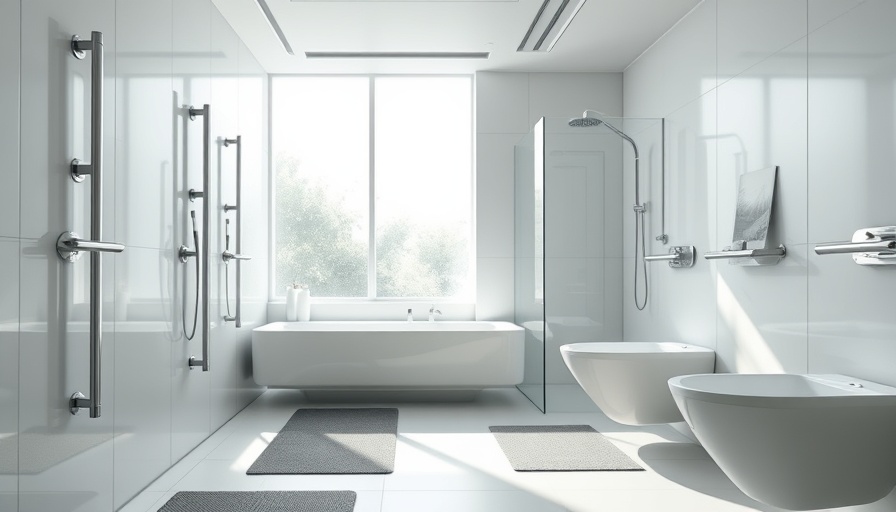
Creating a Safe Haven: Understanding Arthritis Needs
For individuals living with arthritis, even the most mundane tasks can be fraught with challenges. Joint pain, inflammation, and fatigue can make navigating daily routines, particularly in the bathroom, quite daunting. This critical space can be a slippery trap, often overlooked in terms of safety upgrades. Understanding the diverse experiences of those with arthritis is the first step in creating an environment that supports their needs. Each individual is unique, and their specific mobility or pain levels should influence the design choices made.
Smart bathroom upgrades can empower individuals and improve their quality of life significantly, allowing them to maintain their independence while reducing the fear of falls or injuries. Every upgrade should blend safety with aesthetics; a beautifully designed bathroom can boost morale just as effectively as practical modifications.
Transforming Floors for Stability
The foundation of bathroom safety lies in the flooring. Traditional tiles, often favored for their sleek design, can become incredibly hazardous when wet. This can pose severe risks, particularly for individuals dealing with arthritis. To combat slipping, consider installing non-slip vinyl flooring or textured tiles, which provide excellent grip and stability even in wet conditions. These materials are easy to clean yet stylish, offering peace of mind without sacrificing design.
For homeowners unable to replace existing tiles, applying anti-slip treatments is a viable alternative that enhances traction while maintaining appearances. Adding area rugs with rubber backing can also provide further protection without obstructing daily movements in and out of wet areas.
Innovative Fixtures That Make Life Easier
When it comes to making bathrooms safer for those with arthritis, the fixtures play an indispensable role. Upgrading to ergonomic fixtures is a game-changer, significantly improving functionality and usability for individuals with limited grip strength. Consider replacing traditional knobs with lever-style faucets and handles, which require less force. This simple upgrade can make accessing water much easier, removing the frustration associated with twisting and turning.
Additionally, touchless faucets are an excellent option, operating with the wave of a hand, thus eliminating physical exertion entirely. Adjustable-height showerheads or handheld options can enhance comfort, allowing users to wash while standing or sitting, further facilitating a self-sufficient bathing experience.
Bathroom Design Strategies: Enhancements Beyond Fixtures
Beyond just surfaces and fixtures, bathroom layout should also be carefully considered. Think of design strategies that incorporate both open space and storage within easy reach to minimize unnecessary movements. Installing grab bars near the shower, tub, and toilet can provide crucial support, helping individuals maintain balance and stability when transitioning between tasks.
Making the choice to incorporate curbless showers can dramatically improve safety, eliminating the risk of tripping. These showers are not only attractive but also practical, allowing users to enter without any barriers. Furthermore, using contrasting colors for wall and floor designs can help in identifying edges, effectively reducing the risk of falls.
Empowering through Education: Resources and Support
While smart upgrades play an integral part in bathroom safety for those living with arthritis, knowledge is equally important. Education on available resources, such as local support groups and online communities, can empower caregivers and individuals alike. Engaging with such groups allows for knowledge sharing and exploring adaptive strategies that have been useful for others, reinforcing a sense of community.
Furthermore, consulting with professionals specializing in accessibility upgrades can provide invaluable insights into the best solutions tailored to individual needs, ensuring that every aspect of the bathroom caters to safety and comfort.
Taking Action: Transform Your Bathroom Today
Creating a safer bathroom for those with arthritis is not just about functionality; it's about enhancing quality of life. By making these smart upgrades, you're not only helping reduce the risks of injury but also encouraging independence and dignity in daily living. Take the first step towards upgrading your bathroom today and redefine it as a space that truly caters to all its users. Consider reaching out to a local expert who can assist in making these changes, allowing you to navigate life with confidence.
 Add Row
Add Row  Add
Add 




Write A Comment